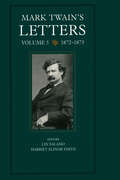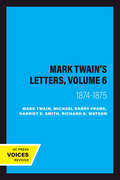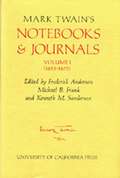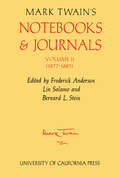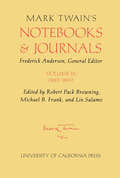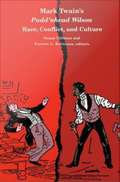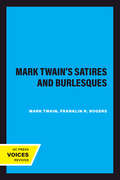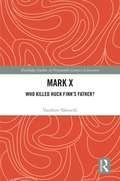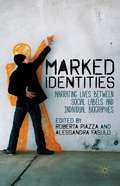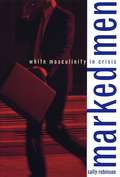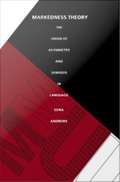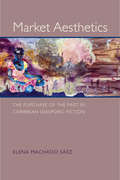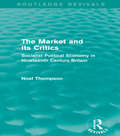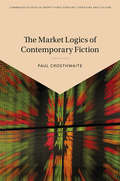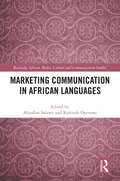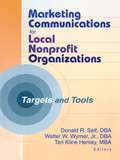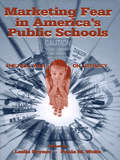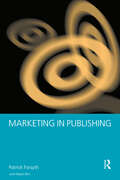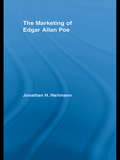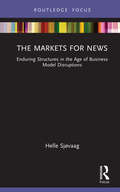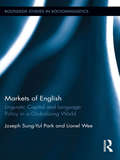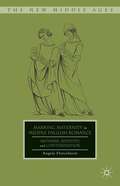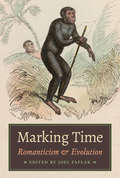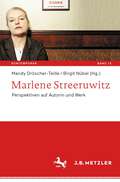- Table View
- List View
Mark Twain's Letters, Volume 5: 1872-1873 (Mark Twain Papers #9)
by Mark Twain"Livy darling, it was flattering, at the Lord Mayor's dinner, tonight, to have the nation's honored favorite, the Lord High Chancellor of England, in his vast wig & gown, with a splendid, sword-bearing lackey, following him & holding up his train, walk me arm-in-arm through the brilliant assemblage, & welcome me with all the enthusiasm of a girl, & tell me that when affairs of state oppress him & he can't sleep, he always has my books at hand & forgets his perplexities in reading them!" (10 November 1872)On his first trip to England to gather material for a book and cement relations with his newly authorized English publishers, Samuel Clemens was astounded to find himself hailed everywhere as a literary lion. America's premier humorist had begun his long tenure as an international celebrity. Meanwhile, he was coming into his full power at home. The Innocents Abroad continued to produce impressive royalties and his new book, Roughing It, was enjoying great popularity. In newspaper columns he appeared regularly as public advocate and conscience, speaking on issues as disparate as safety at sea and political corruption. Clemens's personal life at this time was for the most part fulfilling, although saddened by the loss of his nineteen-month-old son, Langdon, who died of diphtheria. Life in the Nook Farm community of writers and progressive thinkers and activists was proving to be all the Clemenses had hoped for. The 309 letters in this volume, more than half of them never before published, capture the events of these years with detailed intimacy. Thoroughly annotated and indexed, they are supplemented by genealogical charts of the Clemens and Langdon families, a transcription of the journals Clemens kept during his 1872 visit to England, book contracts, his preface to the English edition of The Gilded Age, contemporary photographs of family and friends, and a gathering of all newly discovered letters written between 1865 and 1871. This volume is the fifth in the only complete edition of Mark Twain's letters ever attempted, and the twenty-fourth in the comprehensive edition known as The Mark Twain Papers and Works of Mark Twain.
Mark Twain's Letters, Volume 6: 1874-1875 (Mark Twain Papers #9)
by Mark TwainMark Twain's letters for 1874 and 1875 encompass one of his most productive and rewarding periods as author, husband and father, and man of property. He completed the writing of The Adventures of Tom Sawyer, published the major collection Sketches, New and Old, became a leading contributor to the Atlantic Monthly, and turned The Gilded Age, the novel he had previously coauthored with Charles Dudley Warner, into one of the most popular comedies of the nineteenth-century American stage. His personal life also was gratifying, unmarred by the family tragedies that had darkened the earlier years of the decade. He and his wife welcomed a second healthy daughter and moved into the showplace home in Hartford, Connecticut, that they occupied happily for the next sixteen years. All of these accomplishments and events are vividly captured, in Mark Twain's inimitable language and with his unmatched humor, in letters to family and friends, among them some of the leading writers of the day. The comprehensive editorial annotation supplies the historical and social context that helps make these letters as fresh and immediate to a modern audience as they were to their original readers.This volume is the sixth in the only complete edition of Mark Twain's letters ever attempted. The 348 letters it contains, many of them never before published, have been meticulously transcribed, either from the original manuscripts (when extant) or from the most reliable sources now available. They have been thoroughly annotated and indexed and are supplemented by genealogical charts, contemporary notices of Mark Twain and his works, and photographs of him, his family, and his friends.
Mark Twain's Notebooks and Journals, 1855-1873, Vol. 1
by Mark Twain Frederick Anderson Michael B. Frank Kenneth M. SandersonIn this book authors briefly explain here and there upon the set of journals, diaries, or common place books which through a period of nearly fifty years he had kept and, what is still more remarkable, preserved.
Mark Twain's Notebooks and Journals, Volume II: 1877-1883 (Mark Twain Papers #8)
by Mark TwainThe twelve notebooks in volume 1 provided information about the eighteen years in which the most profound, even dramatic, changes took place in Clemens' life. He early achieved the limits of his boyhood ambition by becoming a steamboat pilot on the Mississippi River, a position there is no reason to believe he would have abandoned if the Civil War had not forced him to do so. In fleeing from a war which principle and temperament prevented him from supporting, Clemens entered into the first stages of his literary career by serving as a reporter for newspapers in Virginia City and San Francisco. When the restricted experiences available to a local reporter had been thoroughly explored, he moved on as a traveling correspondent to the Sandwich Islands and then still farther to Europe and the Near East. The latter travels provided him with material for The Innocents Abroad, the book that established Mark Twain as a popular author with an international reputation in 1869. In 1872 he further exploited his personal history by publishing Roughing It and in the same year visited England to gather material on English people and institutions. He returned to England the following year, this time accompanied by his family and by a secretary who would record the observations printed as the last notebook in volume 1. Volume 2 of Mark Twain's Notebooks and Journals, documenting Clemens' activities in the years from 1877 to 1883, consists largely of the record of three trips which would serve as the source for three travel narratives: the excursion to Bermuda, a prolonged tour of Europe, and an evocative return to the Mississippi River. Despite the common impulse to preserve observations and impressions for literary use, the contents of the notebooks are remarkably different in their vitality-and the works which developed from the notes are correspondingly varied.
Mark Twain's Notebooks and Journals, Volume III: 1883-1891 (Mark Twain Papers #8)
by Mark TwainVolume III of Mark Twain's notebooks spans the years 1883 to 1891, a period during which Mark Twain's personal fortunes reached their zenith, as he emerged as one of the most successful authors and publishers in American literary history. During these years Life on the Mississippi, Adventures of Huckleberry Finn, and a Connecticut Yankee in King Arthur's Court appeared, revealing the diversity, depth, and vitality of Mark Twain's literary talents. With his speeches, his public performances, and his lecture tour of 1884/1885, he became the most recognizable of national figures. At the same time, Mark Twain's growing fame and prosperity allowed him to plunge deeply into the business world, a sphere not suited to his erratic energies. He created the subscription publish firm of Charles L. Webster & Company, Which published the most profitable book of its time, the Personal Memoirs of U.S. Grant. And he became the primary financial support for the ingenious but imperfectible Paige typesetter. Within a few years both the publishing company and the typesetter had taxed Mark Twain's patience, and pocket, beyond endurance. The near bankruptcy of the publishing firm and the debacle of the typesetter scheme finally resulted in 1891 in a drastic decision--to leave the house in Hartford, Connecticut, which had long been the symbol of Mark Twain's rising fortunes and idyllic family life, and move to Europe for an indefinite period in the hope of reducing the family's living expenses. The Clemens family would never return to the Hartford house, and the European stay would lengthen into an almost unbroken nine years of exile. Mark Twain's notebooks permit an intimate view of this turbulent period, whose triumphs were tempered by intimations of financial disaster and personal bitterness.
Mark Twain's Pudd'nhead Wilson: Race, Conflict, and Culture
by Susan Gillman Forrest G. RobinsonThis collection seeks to place Pudd'nhead Wilson--a neglected, textually fragmented work of Mark Twain's--in the context of contemporary critical approaches to literary studies. The editors' introduction argues the virtues of using Pudd'nhead Wilson as a teaching text, a case study in many of the issues presently occupying literary criticism: issues of history and the uses of history, of canon formation, of textual problematics, and finally of race, class, and gender. In a variety of ways the essays build arguments out of, not in spite of, the anomalies, inconsistencies, and dead ends in the text itself. Such wrinkles and gaps, the authors find, are the symptoms of an inconclusive, even evasive, but culturally illuminating struggle to confront and resolve difficult questions bearing on race and sex. Such fresh, intellectually enriching perspectives on the novel arise directly from the broad-based interdisciplinary foundations provided by the participating scholars. Drawing on a wide variety of critical methodologies, the essays place the novel in ways that illuminate the world in which it was produced and that further promise to stimulate further study. Contributors. Michael Cowan, James M. Cox, Susan Gillman, Myra Jehlen, Wilson Carey McWilliams, George E. Marcus, Carolyn Porter, Forrest Robinson, Michael Rogin, John Carlos Rowe, John Schaar, Eric Sundquist
Mark Twain's Satires and Burlesques (Mark Twain Papers #3)
by Mark TwainFrom the Introduction:It should always be with some misgivings that an editor presents to the public materials which an author has discarded. By returning the materials to his files, the author has voted against publication. By resurrecting them, the editor risks exposing the author to the adverse criticism which he wished to avoid. But, at the same time, the resurrection serves a valuable purpose by making available indispensable evidence to be used by those seeking to understand the creative process. It is because they serve such a purpose that the texts published in this volume have been salvaged from Mark Twain's files. Indeed, they are doubly valuable because they aid in dispelling a myth about his own creative process which Twain himself did much to establish. In several instances Twain gave the impression that for him plotting a novel was a rather simple affair. . . . But in actuality, as the texts published in this volume illustrate, he experienced much more trouble than this statement would suggest in delimiting his fictional world, establishing its nature, and maintaining control over the characters placed therin.
Mark Twain's "Which Was the Dream?" and Other Symbolic Writings of the Later Years
by Mark Twain John S. TuckeyAll of these selections in this volume were composed between 1896 and 1905. Mark Twain wrote them after the disasters of the early and middle nineties that had included the decline into bankruptcy of his publishing business, the failure of the typesetting machine in which he invested heavily, and the death of his daughter Susy. Their principal fable is that of a man who has been long favored by luck while pursuing a dream of success that has seemed about to turn into reality. Sudden reverses occur and he experiences a nightmarish time of failure. He clutches at what may be a saving thought: perhaps he is indeed living in a nightmare from which he will awaken to his former felicity. But there is also the possibility that what seems a dream of disaster may be the actuality of his life. The question is the one asked by the titles that he gave to two of his manuscripts: "Which Was the Dream?" and "Which Was It?" He posed a similar question in 1893: "I dreamed I was born, and grew up, and was a pilot on the Mississippi, and a miner and journalist...and had a wife and children...and this dream goes on and on and on, and sometimes seems so real that I almost believe it is real. I wonder if it is?" Behind this naive query was his strong interest in conscious and unconscious levels of mental experience, which were then being explored by the new psychology.
Mark X: Who Killed Huck Finn’s Father? (Routledge Studies in Nineteenth Century Literature)
by Yasuhiro TakeuchiIn the summer of 1876, Mark Twain started to write Adventures of Huckleberry Finn as a detective novel surrounding the murder of Huck’s father, Pap Finn. The case is unresolved in the novel as it exists today, but Twain had already planted the clue to the identity of the killer. It is not the various objects ostentatiously left around Pap’s naked body; they are not the foreground of the scene, but actually the background, against which a peculiar absence emerges distinctively—Pap’s boots, with a "cross" in one of the heels, are gone with his murderer. The key to the mystery of Twain’s writings, as this book contends from a broader perspective, is also such an absence. Twain’s persistent reticence about the death of his father, especially the autopsy performed on his naked body, is a crucial clue to understanding his works. It reveals not only the reason why he aborted his vision of Huckleberry Finn as a detective novel, but also why, despite numerous undertakings, he failed to become a master of detective fiction.
Marked Identities
by Roberta Piazza Alessandra FasuloWestern society has become increasingly diverse, but stereotypes still persist in the public discourse. This volume explores how people who have a marked status in society - among them Travellers, teenage mothers, homeless people - manage their identity in response to these stereotypes.
Marked Men: White Masculinity in Crisis
by Sally RobinsonWhite men still hold most of the political and economic cards in the United States; yet stories about wounded and traumatized men dominate popular culture. Why are white men jumping on the victim bandwagon? Examining novels by Philip Roth, John Updike, James Dickey, John Irving, and Pat Conroy and such films as Deliverance, Misery, and Dead Poets Society—as well as other writings, including The Closing of the American Mind—Sally Robinson argues that white men are tempted by the possibilities of pain and the surprisingly pleasurable tensions that come from living in crisis.
Markedness Theory: The Union of Asymmetry and Semiosis in Language
by Edna AndrewsEdna Andrews clarifies and extends the work of Roman Jakobson to develop a theory of invariants in language by distinguishing between general and contextual meaning in morphology and semantics. Markedness theory, as Jakobson conceived it, is a qualitative theory of oppositional binary relations. Andrews shows how markedness theory enables a linguist to precisely define the systemically given oppositions and hierarchies represented by linguistic categories. In addition, she redefines the relationship between Jakobsonian markedness theory and Peircean interpretants. Though primarily theoretical, the argument is illustrated with discussions about learning a second language, the relationship of linguistics to mathematics (particularly set theory, algebra, topology, and statistics) in their mutual pursuit of invariance, and issues involving grammatical gender and their implications in several languages.
Market Aesthetics: The Purchase of the Past in Caribbean Diasporic Fiction (New World Studies)
by Elena Machado SáezIn Market Aesthetics, Elena Machado Sáez explores the popularity of Caribbean diasporic writing within an interdisciplinary, comparative, and pan-ethnic framework. She contests established readings of authors such as Junot Díaz, Julia Alvarez, Edwidge Danticat, and Robert Antoni while showcasing the work of emerging writers such as David Chariandy, Marlon James, and Monique Roffey. By reading these writers as part of a transnational literary trend rather than within isolated national ethnic traditions, the author is able to show how this fiction adopts market aesthetics to engage the mixed blessings of multiculturalism and globalization via the themes of gender and sexuality. New World Studies Modern Language Initiative
The Market and its Critics: Socialist Political Economy in Nineteenth Century Britain (Routledge Revivals)
by Noel ThompsonThe Market and Its Critics, first published in 1988, considers the reaction of socialist writers to the growth of the market economy in nineteenth century Britain, and examines in detail the diverse elements of the critique which they formulated. Dr Thompson looks at the theoretic and thematic continuities and discontinuities over the century, structuring his study around the idea of a changing socialist response to the market economy. Much of the literature in question is comprehensive, perceptive and acute. However, the writers invariably discounted the possibility of the market playing a role in a future socialist or communist commonwealth. The solutions they posited to the problem were inapplicable to the increasingly industrial economy of the time. It was this that left their writing vulnerable to attack, and which had profound consequences both for the fate of the socialist political economy in nineteenth century Britain and its subsequent evolution in the twentieth century.
The Market Logics of Contemporary Fiction (Cambridge Studies in Twenty-First-Century Literature and Culture)
by Paul CrosthwaiteIn the twenty-first century, leading publishers are under intense pressure from their conglomerate owners and shareholders to generate growth and profits. This book shows how these pressures have transformed the contemporary novel. Paul Crosthwaite argues that recent British and American authors have internalized the market logics of the financial sector and book trade, resulting in the production of works of 'market metafiction' in which authors reflect obsessively on their writing's positioning in the literary marketplace. The Market Logics of Contemporary Fiction reveals the entanglement of fictional narrative and market dynamics to be the central phenomenon of contemporary literary culture. It engages with work by key authors including Iain Sinclair, Don DeLillo, Kathy Acker, Bret Easton Ellis, Chris Kraus, Percival Everett, David Foster Wallace, Colson Whitehead, Anne Billson, Hari Kunzru, Barbara Browning, Teju Cole, Ben Lerner, Tao Lin, Nell Zink, Joshua Cohen, Sheila Heti, and Garth Risk Hallberg.
Marketing Communication in African Languages (Routledge African Media, Culture and Communication Studies)
by Abiodun Salawu Kehinde OyesomiThis edited volume considers the use of African languages for marketing communication. The importance of an indigenous language stems from its benefits, which include increased comprehension and a sense of resonance among the target audience, which makes it more memorable as opposed to foreign languages.Chapters in the book variously examine African traditional advertising and marketing; popular culture as a channel for advertising and marketing; political communication, advertising and marketing; commercials and public relations in African languages; as well as branding, corporate and public communication in African languages. The use of African languages for marketing communication is considered on the traditional mass media and the digital media. Readers will gain a lot of insights into the theory and practice of marketing communication in African languages.
Marketing Communications for Local Nonprofit Organizations: Targets and Tools
by Teri Kline Henley Walter W Wymer, Jr Donald SelfHelp your nonprofit organization keep up with the competition!As the competition for funding among nonprofit organizations becomes more intense, so does the need to develop survival strategies that focus limited resources in the most effective ways. Marketing Communications for Local Nonprofit Organizations: Targets and Tools presents proven methods for effectively reaching the target markets essential to your organization&’s future. This practical guidebook is divided into two easy-to-use sections: “Targets” details how to develop employees and volunteers, form alliances with for-profit organizations, and develop social entrepreneurship programs; “Tools” explains how to make maximum use of communications and media (advertising, direct marketing, public relations), fundraising, and Internet and e-commerce potential.Marketing Communications for Local Nonprofit Organizations: Targets and Tools also provides expert guidance on: multimedia marketing, including Web conferencing event planning and promotion branding and positioning promotional products tax, legal, cultural, and financial issues and much more!Marketing Communications for Local Nonprofit Organizations: Targets and Tools is an essential handbook for nonprofit organizations as they struggle against reduced government funding and a rapidly changing environment. Educators and students will also find the book invaluable as a how-to marketing guide based on effective methods and proven strategies.
Marketing Fear in America's Public Schools: The Real War on Literacy
by Leslie Poynor Paula M. WolfeMarketing Fear in America's Public Schools: The Real War on Literacy is an eye-opening examination of the real world consequences of the political pressures and influences on teachers today. In particular, it looks at how the political actions of the conservative right disempower and control teachers, school districts, parents, and children through an atmosphere of fear used as a strategy to ensure that schools follow the conservative political agenda supporting and imposing mandates such as increased accountability, high stakes testing, and direct intense direct-instruction phonics programs. The book offers a unique look not at not only what the conservative factions are doing but why. The volume includes chapters on: *resistance to the conservative agenda; *national and/or federal agendas and actions that directly or indirectly contribute to the privatization and corporate control of public education; *the linkage of federal policy to the disappearance or promotion of particular philosophical and pedagogical approaches; and *the role of the media in perpetuating the agendas of the corporate and political right. Many teachers across the U.S. are frustrated and angry about the outside legislative constraints placed on their work, but at the same time frightened of losing their jobs and/or being faced with a lawsuit. The book's premise is that one must understand the motives behind the current educational "reforms" in order to resist them. The editors and contributors envision the volume as a voice for an alternative to compliance with unreasonable mandates--and thus as a message of hope. Marketing Fear in America's Public Schools: The Real War on Literacy is important reading for teachers; teacher educators; education students; school administrators and other education professionals; researchers concerned with literacy, critical theory, pedagogy, and educational policy; and parents and community activists concerned with the politics of schooling and school reform. It is will serve well as a text in a range of courses across the field of education. A Web site for the book can be found at http://www.erlbaum.com/poynor.
Marketing in Publishing (Blueprint Ser.)
by Patrick Forsyth Robin BirnMarketing in Publishing, offers a wealth of practical information on creative strategies to increase book sales in a competitive and rapidly-changing marketplace. It is the first comprehensive study in this area to be published since the ending of the Net Book Agreement.Patrick Forsyth, now a marketing consultant, draws in his many years' experience of the publishing industry to reinstate marketing firmly where it should be: as an integral and integrated part of the whole marketing process.Marketing in Publishing gives expert guidance on different elements of the marketing process, including advice on promotional and direct mail options, and a step-by-step section on how to make an effective sales call. It includes a valuable discussion of fusing market research intelligently to identify new opportunities and market niches. The book also features an authoritative chapter evaluating the importance of electronic publishing.Completely up-to-date, Marketing in Publishing will be essential reading both for those working in marketing and editorial departments, and for students of publishing studies.
The Marketing of Edgar Allan Poe (Studies in American Popular History and Culture)
by Jonathan HartmannEdgar Allan Poe is today considered one of the greatest masters and most fascinating figures of the American literary world. However, an examination of Poe's essays and criticism throughout his prose publishing career (1831-1849) reveals that the author himself played a vital role in the creation and manipulation of his own reputation. During his twenties and thirties, Poe promoted his writing to magazine editors in the United States and in Europe through several strategies. He painted a Romantic and patriotic self-portrait in his fiery literary reviews, even as he played up his own connections, both real and imaginary, to literary celebrities including Washington Irving, Charles Dickens, George Gordon Lord Byron and Samuel Taylor Coleridge. Through recycling plots, atmosphere, and language (including his own) from American and British magazines, he built stories and essays which were linked in a complex network of references to each other and their author. Teachers and students alike will enjoy this single-volume treatment of Poe’s self-promotional tales and criticism.
The Markets for News: Enduring Structures in the Age of Business Model Disruptions (Disruptions)
by Helle SjøvaagIn the face of ongoing digitisation, The Markets for News examines how certain established economic features of the news industry have persisted and what makes them such stable frameworks for journalistic organisations. Drawing on an analysis of Scandinavian news industries, this text revises journalism’s economic foundations in the context of the algorithmically driven platform economy. Exploration of features such as journalism’s two-sided market model, the network effect of platforms, and chain ownership, leads to a discussion about how journalism faces disruption from the introduction of artificial intelligence in the production, dissemination, and sale of news. As journalism undergoes transformations due to revenue losses, this book recognises a return to certain enduring features of journalism’s organisational form, in particular the chain ownership form, that enables scale in adapting to platform logics and economics. This text serves as a basis for a theoretical discussion about strategic media management and critical political economy in the age of digital disruption. This is an insightful book for academics and researchers in the fields of journalism, media industries, media policy and, communication studies.
Markets of English: Linguistic Capital and Language Policy in a Globalizing World (Routledge Studies in Sociolinguistics)
by Joseph Sung-Yul Park Lionel WeeThe global spread of English both reproduces and reinforces oppressive structures of inequality. But such structures can no longer be seen as imposed from an imperial center, as English is now actively adopted and appropriated in local contexts around the world. This book argues that such conditions call for a new critique of global English, one that is sensitive to both the political economic conditions of globalization and speakers’ local practices. Linking Bourdieu’s theory of the linguistic market and his practice-based perspective with recent advances in sociolinguistics and linguistic anthropology, this book offers a fresh new critique of global English. The authors highlight the material, discursive, and semiotic processes through which the value of English in the linguistic market is constructed, and suggest possible policy interventions that may be adopted to address the problems of global English. Through its serious engagement with current sociolinguistic theory and insightful analysis of the multiple dimensions of English in the world, this book challenges the readers to think about what we need to do to confront the social inequalities that are perpetuated by the global spread of English
Marking Maternity In Middle English Romance
by Angela FlorschuetzWorking at the intersection of medical, theological, cultural, and literary studies, this book offers an innovative approach to understanding maternity, genealogy and social identity as they are represented in popular literature in late-medieval England.
Marking Time: Romanticism and Evolution
by Joel FaflakScholars have long studied the impact of Charles Darwin’s writings on nineteenth-century culture. However, few have ventured to examine the precursors to the ideas of Darwin and others in the Romantic period. Marking Time, edited by Joel Faflak, analyses prevailing notions of evolution by tracing its origins to the literary, scientific, and philosophical discourses of the long nineteenth century. The volume’s contributors revisit key developments in the history of evolution prior to The Origin of Species and explore British and European Romanticism’s negotiation between the classic idea of a great immutable chain of being and modern notions of historical change. Marking Time reveals how Romantic and post-Romantic configurations of historical, socio-cultural, scientific, and philosophical transformation continue to exert a profound influence on critical and cultural thought.
Marlene Streeruwitz: Perspektiven auf Autorin und Werk (Kontemporär. Schriften zur deutschsprachigen Gegenwartsliteratur #12)
by Mandy Dröscher-Teille Birgit NübelMarlene Streeruwitz ist eine der streitbarsten politischen Autor*innen der Gegenwart. Literatur ist ihr nicht nur politisches Instrument, sondern als »Modell der Welt in Sprache« zugleich auch ästhetisch autonom. Die Beiträge dieses Bandes diskutieren die Weiterschreibungen, Gegen- und Neukonstruktionen der außertextuellen Welt in den Prosatexten, Essays, Vorlesungen und crossmedialen Projekten der Autorin. In den Blick genommen wird das Welt- und Lebenswissen der Literatur, ihr Beitrag zu unserer Trauer und Resistenz, Erinnerungs- und Überlebensfähigkeit – zwischen Glück, Lust, Liebe, (Für )Sorge und Schmerz. Marlene Streeruwitz trägt – neben einem Gespräch mit den beiden Herausgeberinnen – einen Originalbeitrag sowie einen bisher ungedruckten poetologischen Essay zum Band bei.
